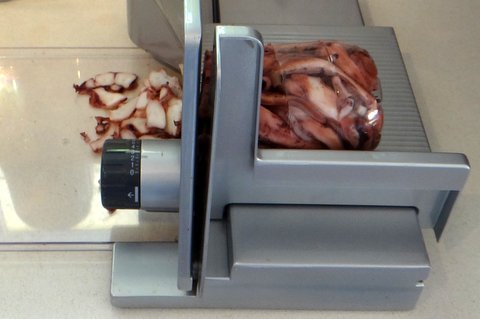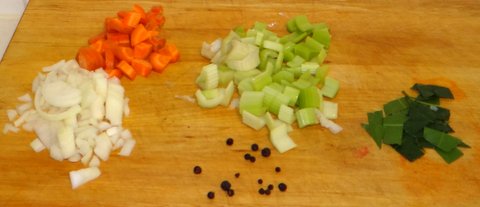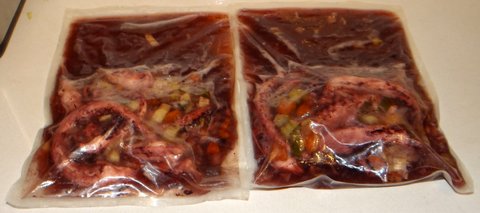Octopus can be very tough and bland, but when you cook it sous-vide it will be tender and flavorful. I wrote about sous-vide octopus (Insalata di Polpo) before, but since octopus sous-vide is so good and I saw a nice idea on GialloZafferano that enables you to slice the octopus more thinly, I decided to write about it some more. The photos on GZ suggest that you can actually get slices of octopus ‘sausage’, but since there is no ‘glue’ to hold them together that doesn’t happen and the slices fall apart. It still looks great, and the thin slices make the octopus even more tender. It would be nice to think of something to make them stick together, because it would look even nicer that way.
Ingredients
For 6 servings as an appetizer
2 kilograms (4.4 lbs) octopus
2 bay leaves
1 carrot
1 onion
6 juniper berries
6 black pepper corns
2 celery stalks
salt
For serving
1 lemon
extra virgin olive oil
fresh flatleaf parsley
salt
garlic (optional)
tomatoes (optional)
Preparation
Roughly chop the onion, carrot, celery and bay leaves.
Season the octopus ligthly with salt. Put the octopus in 1 or 2 sous-vide pouches with the onion, carrot, celery, bay leaves, juniper berries, and pepper corns. I used zip pouches because the octopus releases a lot of liquid and can therefore be difficult to seal with a FoodSaver-type vacuum sealer.
Cook sous-vide for 5 to 7 hours at 77C/170F. The octopus will release a lot of liquid, that is normal.
Drain the octopus and remove all the vegetables and spices.
Cut the top of a plastic water bottle (preferably still water) and punch a few small holes in the bottom. Put the octopus legs in the bottle as vertically and with as little space remaining in between as possible.
Use a wine bottle or something else (that you cleaned first) to push down on the octopus in the plastic bottle.
Cut incisions into the top using scissors, about 1 cm or 1/2 inch apart.
Fold the tops towards the middle to close the top.
Wrap in plastic wrap and put something heavy on top. Refrigerate for 24 hours with some kitchen paper underneath to catch the liquid that will come out.
Remove most of the plastic bottle, keep only about 5 cm (2 inches) of the bottom end for a hold.
Slice as thinly as possible (1-2 mm or 15-25 slices per inch), preferably using a slicing machine if you have one.
Make a dressing to taste out of extra virgin olive oil, parsley, lemon juice and salt. Add some minced garlic if you like.
Serve with the dressing and a slice of lemon.
I recently had this dish in Varazze in Liguria, where it was served with some chopped fresh tomatoes as well and I thought that was a nice touch that I will add myself next time I’ll make this.
















Lovely. On getting it to stay together, could you make a herb gelatine? It might be worth a go?
Best,
Conor
LikeLike
Good suggestion, I’ll have to try something like that. Thanks!
LikeLike
I tried making a gelatine of the liquid from the sous-vide pouch. It looked very nice and I could slice it a bit thinner at first (straight drom the fridge), but the slices still fell apart. The gelatine isn’t sticky enough apparently. I might have to try one of those enzymes they write about in Modernist Cuisine…
LikeLike
Transglutinamase Activa RM is the answer to getting it to stick together. Commonly known as meat glue and available from Modernist Pantry. Give it a try
LikeLike
Thanks Rob, I’ll have to give that a try. I wonder if it’ll work AFTER cooking though?
LikeLike
Oh oh oh – can’t wait to try this! I don’t have a slicing machine, but I’ll do the best I can! Terri
LikeLike
Enjoying your site so I’m nominating you for the Illuminating Blogger Award for informative, illuminating blog content. I know not everyone participates in blog awards but I hope you’ll at least check it out because it’s a great way to discover new blogs and meet new web friends. If you’re interested in participating, you can check out the details at my site … http://foodstoriesblog.com/illuminating-blogger-award/ … Either way, hope you’re having a great day!
LikeLike
Thanks so much!
LikeLike
the fat on the pulpo skin when gently cooked will bind the pieces, so slicing the carpaccio is posible. if activia rm is used. disregard the fatty skin of the octopus because activia rm and fat do not work well.
LikeLike
Thanks! Will try and report back.
LikeLike